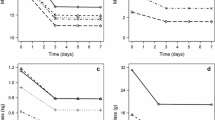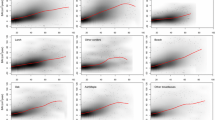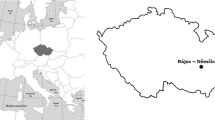Abstract
The applicability of a heuristic model for estimating mean fine-root biomass of Norway spruce stands based on the coordinates and the diameters at breast height (diameter at a height of 1.3 m, dbh) of their trees was tested. The model was developed based on the following assumptions which were derived from the literature: (1) the maximum distance the roots of a tree can be found depends on the dimension of the tree and exceeds the edges of the crown; (2) fine-root biomass decreases with increasing distance from the tree trunk; (3) fine-root biomass increases with the dbh; (4) maximum fine-root biomass of a tree is not allocated directly around the tree’s trunk but at some distance from the stem. On the basis of these assumptions the model calculates a relative fine-root biomass at a given point within a stand. Four different versions of the model were compared, with each version differing with respect to the assumed decrease in fine roots with decreasing dbh and the approaches used to calculate the contribution of a subject tree to the fine-root biomass at a given point within a stand (additive versus consumptive). Using regression analysis we parameterised each model type with the data of 70 soil cores from a 75-year-old Norway spruce stand in southern Germany (Bavaria). The relative fine-root biomass calculated by the four different model types accounted for 62–72% of the variation of the measured fine-root biomass. The parameterised models were used to predict the fine-root biomass of 60 given points of a second Norway spruce stand based on its dbhs and stem coordinates. The comparison of measured and predicted mean fine-root biomasses of the second stand revealed no significant differences between the measured mean and the means estimated by three of the four model types. Whereas with two of the model types we achieved means and medians, respectively, nearly identical to the measured average, none of the model types was able to predict values as high as the measured maximum. Constraints of the models and points that need to be considered regarding the minimum number of soil cores needed for a reliable parameterisation of the model are discussed.


Similar content being viewed by others
References
Ammer Ch (2000) Untersuchungen zum Einfluss von Fichtenaltbeständen auf die Entwicklung junger Buchen. Shaker, Aachen
Ammer Ch (2002a) Response of Fagus sylvatica seedlings to root trenching of overstorey Picea abies. Scan J For Res 17:408–416
Ammer Ch (2002b) (ed) Altholzwurzelkonkurrenz—eine Herausforderung für die Verjüngungsmodellierung. In: Proc Sekt Waldbau Verbandes Dtsch Forstlicher Forschungsanst. Berliner Forsten, Berlin, pp 72–84
Ammer Ch, Wagner S (2002) Problems and options in modelling fine root biomass of single mature Norway spruce trees at given points from stand data. Can J For Res 32:581–590
Ammer Ch, Mosandl R, El Kateb H (2002) Direct seeding of beech (Fagus sylvatica L.) in Norway spruce (Picea abies [L.] Karst.) stands—effects of canopy density and fine rot biomass on seed germination. For Ecol Manage 159:59–72
Aussenac G (2000) Interactions between forest stands and microclimate: ecophysiological aspects and consequences for silviculture. Ann For Sci 57:287–301
Bauhus J, Bartsch N (1996) Fine-root growth in beech (Fagus sylvatica) forest gaps. Can J For Res 26:2153–2159
Björse G, Bradshaw R (1998) 2000 years of forest dynamics in southern Sweden: suggestions for forest management. For Ecol Manage 104:15–26
Böhm W (1979) Methods of studying root systems. Ecological studies, vol 33. Springer, Berlin Heidelberg New York
Böswald K (1996) Zur Bedeutung des Waldes und der Forstwirtschaft im Kohlenstoffhaushalt, eine Analyse am Beispiel des Bundeslandes Bayern. Forstl Forschungsber München 159
Bolte A, Hertel D, Ammer Ch, Schmid I, Nörr R, Kuhr M, Redde N (2003) Freilandmethoden zur Untersuchung von Baumwurzeln. Forstarchiv 74:240–262
Brockway DG, Outcalt KW (1998) Gap-phase regeneration in longleaf pine wiregrass ecoystems. For Ecol Manage 106:125–139
Burke MK, Raynal DJ (1994) Fine root growth phenology, production, and turnover in a northern hardwood forest ecosystem. Plant Soil 162:135–146
Burschel P, Weber M (2001) Wald-Forstwirtschaft-Holzindustrie: zentrale Grössen der Klimapolitik. Forstarchiv 72:75–85
Campbell JJ, Finér L, Messier C (1998) Fine-root production in small experimental gaps in successional mixed boreal forests. J Veg Sci 9:537–542
Clemensson-Lindell A, Persson H (1995) The effects of nitrogen addition and removal on Norway spruce fine-root vitality and distribution in three catchment areas at Gårdsjön. For Ecol Manage 71:123–131
Collet C, Lanter O, Pardos (2002) Effects of canopy opening on the morphology and anatomy of naturally regenerated beech seedlings. Trees 16:291–298
Coomes DA, Grubb PJ (2000) Impacts of root competition in forests and woodlands: a theoretical framework and review of experiments. Ecol Monogr 70:171–207
Drexhage M (1994) Die Wurzelentwicklung 40-jähriger Fichten (Picea abies [L.] Karst.) in der Langen Bramke (Harz). Ber Forschungszentrums Waldökosysteme A 111
Drexhage M, Colin F (2001) Estimating root system biomass from breast-height diameters. Forestry 74:491–497
Drexhage M, Gruber F (1999) Above- and belowground relationships for Picea abies: estimating root sxstem biomass from breast-height diameters. Scan J For Res 14:328–333
Dufner J, Jensen U, Schumacher E (1992) Statistik mit SAS. Teubner, Stuttgart
Friedrich J (1992) Räumliche Variation bodenchemischer und -physikalischer Merkmalsgrössen sowie der Wurzelverteilung in Buchen- und Fichtenwaldökosystemen. Ber Forschungszentrums Waldökosysteme A 83
Gerhardt K (1996) Effects of root competition and canopy openness on survival and growth of tree seedlings in a tropical seasonal dry forest. For Ecol Manage 82:33–48
Helmisaari H-S, Hallbäcken L (1999) Fine-root biomass and necromass in limed and fertilized Norway spruce (Picea abies (L.) Karst.) stands. For Ecol Manage 119:99–110
Hilf HH (1927) Wurzelstudien an Waldbäumen. Die Wurzelausbreitung und ihre waldbauliche Bedeutung. Schaper, Hannover
Irrgang S (1999) Kiefern-Waldumbauversuche der Sächsischen Landesanstalt für Forsten. Konzeption und bisherige Ergebnisse. Forst Holz 54:323–330
Jones RH, Mitchell RJ, Stevens GN, Pecot SD (2003) Controls of fine root dynamics across a gradient of gap sizes in a pine woodland. Oecologia 134:132–143
Kalela EK (1950) On the horizontal roots in pine and spruce stand I. Acta For Fenn 57:1–79
Kenk GK (1992) Silviculture of mixed species stands in Germany. In: Cannell MGR, Malcolm DC, Robertson PA (eds) The ecology of mixed-species stands of trees. Special publication No. 11 of the British Ecological Society. Blackwell, Oxford, pp 53–63
Kurz WA, Kimmins JP (1987) Analysis of some sources of error in methods used to determine fine root production in forest ecosystems: a simulation approach. Can J For Res 17:909–912
Kurz WA, Beukema SJ, Apps MJ (1996) Estimation of root biomass and dynamics for the carbon budget model of the Canadian sector. Can J For Res 26:1973–1979
Kuuluvainen T, Pukkala T (1989) Effect of Scots pine seed trees on the density of ground vegetation and tree seedlings. Silva Fenn 23:159–167
Leder B, Hillebrand K (2001) Überlegungen zur Charakterisierung der Qualitätsentwicklung in Buchen-Jungwüchsen. Forst Holz 56:44–49
Leder B, Wagner S (1996) Bucheckern/Streu-Voraussaat als Alternative beim Umbau von Nadelholzreinbeständen in Mischbestände. Forstarchiv 67:7–13
Leder B, Wagner S, Wollmerstädt J, Ammer Ch (2003) Bucheckern-Voraussaat unter Fichtenschirm—Ergebnisse eines Versuchs des Deutschen Verbandes Forstlicher Forschungsanstalten/Sektion Waldbau. Forstwiss Centralbl 120:160–174
Le Goff N, Ottorini J-M (2001) Root biomass and biomass increment in a beech (Fagus sylvatica L.) stand in North-East France. Ann For Sci 58:1–13
Leuschner C, Backes K, Hertel D, Schipka F, Schmitt U, Terborg O, Runge M (2001) Draught responses at leaf, stem and fine root levels of competitive Fagus sylvatica L. and Quercus petraea (Matt.) Liebl. trees in dry and wet years. For Ecol Manage 149:33–46
López B, Sabaté S, Gracia CA (2001) Annual and seasonal changes in fine root biomass of a Quercus ilex L. forest. Plant Soil 230:125–134
Lüpke B von, Ammer Ch, Braciamacchie M, Brunner A, Ceitel J, Collet C, Deuleuze C, Di Placido J, Huss J, Jankovic J, Kantor P, Larsen JB, Lexer M, Löf M, Longauer R, Madsen P, Modrzynski J, Mosandl R, Pampe A, Pommerening A, Stefancik J, Tesar V, Thompson R, Zientarski J (2004) Silvicultural strategies for conversion. In: Spiecker H, Hansen J, Klimo E, Skovsgaard JP, Sterba H, Teuffel Kv (eds) Norway spruce conversion—options and consequences 18. Brill, Leiden, pp 121–164
Mäkela A, Vanninen P (2000) Estimation of fine root mortality and growth from simple measurements: a method based on system dynamics. Trees 14:316–323
Makkonen K, Helmisaari H-S (1998) Seasonal and yearly variations of fine-root biomass and mecromass in a Scots pine (Pinus sylvestris L.) stand. For Ecol Manage 102:283–290
McClaugherty CA, Aber JD, Melillo JM (1982) The role of fine roots in the organic matter and nitrogen budgets of two forest ecosystems. Ecology 63:1481–1490
Meyer FH (1967) Feinwurzelverteilung bei Altbäumen in Abhängigkeit vom Substrat. Forstarchiv 38:286–290
Müller K, Wagner S (2003) Fine-root dynamics in gaps of Norway spruce stands in the Germany Ore mountains. Forestry 76:149–158
Murach D (1984) Die Reaktion der Feinwurzeln von Fichten (Picea abies [L.] Karst. auf zunehmende Bodenversauerung. Göttinger Bodenkundl Ber 77:1–126
Nadelhoffer KJ, Raich JW (1992) Fine root production estimates and belowground carbon allocation in forest ecosystems. Ecology 73:1139–1147
Nadelhoffer KJ, Aber JD, Melillo JM (1985) Fine roots net primary production and soil nitrogen availability: a new hypothesis. Ecology 66:1377–1390
Nielsen C Ch N, Mackenthun G (1991) Die horizontale Variation der Feinwurzelintensität in Waldböden in Abhängigkeit von der Bestockungsdichte. Eine rechnerische Methode zur Bestimmung der “Wurzelintensitätsglocke” an Einzelbäumen. Allg Forst Jagdg Ztg 162:112–119
Parsons WFJ, Miller SL, Knight DH (1994) Root gaps dynamics in a lodgepole pine forest: ectomycorrhizal and nonmycorrhizal fine root activity after experimental gap formation. Can J For Res 24:1531–1538
Persson H (1983) The distribution and productivity of fine roots in boreal forests. Plant Soil 71:87–101
Persson H (1996) Fine-root dynamics in forest trees. Acta Phytogeogr Suec 81:17–23
Polomski J, Kuhn N (1998) Wurzelsysteme. Haupt, Bern
Puhe J (1994) Die Wurzelentwicklung der Fichte (Picea abies [L.] Karst. bei unterschiedlichen chemischen Bodenbedingungen. Ber Forschungszentrums Waldökosysteme A 108
Puhe J(2003) (2003) Growth and development of the root system of Norway spruce (Picea abies) in forest stands—a review. For Ecol Manage 175:253–273
Quinn GP, Keough MJ (2002) Experimental design and data analysis for biologists. University Press, Cambridge
Rohner M, Böswald K (2001) Forestry development scenarios: timber production, carbon dynamics in tree biomass and forest values in Germany. Silva Fenn 35:277–297
Santantonio D, Grace J C (1987) Estimating fine-root production and turnover from biomass and decomposition data: a compartment-flow model. Can J For Res 17:900–908
Santantonio D, Herrmann R K (1985) Standing crop production and turnover of fine roots on dry moderate and wet sites of mature Douglas-fir (Pseudotsuga menziesii) in Western Oregon USA. Ann Sci For 42:113–142
Santantonio D, Herrmann RK, Overton WS (1977) Root biomass studies in forest ecosystems. Pedobiologia 17:1–31
Schmid I, Kazda M (2002) Root distribution of Norway Spruce in monospecific and mixed stands on different soils. For Ecol Manage 159:37–47
Stöcker H (ed) (1995) Taschenbuch mathematischer Formeln und moderner Verfahren, 3rd edn. Harri Deutsch, Thun
Stone EL, Kalisz PJ (1991) On the maximum extent of tree roots. For Ecol Manage 46:59–102
Taskinen O, Ilvesniemi H, Kuuluvainen T, Leinonen K (2003) Response of fine roots to an experimental gap in a boreal Picea abies forest. Plant Soil 255:503–512
Vanninen P, Mäkela A (1999) Fine root biomass of Scots pine stands differing in age and soil fertility in southern Finland. Tree Physiol 19:823–830
Vater H (1927) Die Bewurzelung der Kiefer, Fichte und Buche. Tharandter Forstl Jahrb 78:65–85
Vogt KA (1991) Carbon budgets of temperate forest ecosystems. Tree Physiol 9:69–86
Vogt KA, Vogt DJ, Palmiotto PA, Boon P, O’Hara J, Asbjornsen H (1996) Review of root dynamics in forest ecosystems grouped by climate, climatic forest type and species. Plant Soil 187:159–219
Wagner S (1999) Ökologische Untersuchungen zur Initialphase der Naturverjüngung in Eschen-Buchen-Mischbeständen. Schriften a d Forstlichen Fakultät d Universität Göttingen u d Niedersächsischen Forstlichen Versuchsanstalt 129. Sauerländers, Frankfurt
Wiedemann E (1927) Der Wurzelbau älterer Waldbäume. Forstarchiv 3:229–233
Wittkopf S (1995) Wurzelintensität im Fichten–Buchen–Mischbestand im Vergleich zum Reinbestand. Untersuchungen zur Wurzelintensität im Fichtenreinbestand, Buchenreinbestand und Mischbestand mittels Bohrkernmethode unter Berücksichtigung bodenchemischer Parameter. PhD thesis Ludwig-Maximilians-Universität München
Wu HI, Sharpe PJH, Walker J, Penrigde LK (1985) Ecological field theory: a spatial analysis of resource interference among plants. Ecol Model 29:215–243
Acknowledgements
We thank J. and K. Schweiger and K. Thoroe for their assistance in the field and in the laboratory. We also thank D. Dunn for English corrections and we appreciate the comments from two anonymous reviewers that have improved this manuscript.
Author information
Authors and Affiliations
Corresponding author
Rights and permissions
About this article
Cite this article
Ammer, C., Wagner, S. An approach for modelling the mean fine-root biomass of Norway spruce stands. Trees 19, 145–153 (2005). https://doi.org/10.1007/s00468-004-0373-4
Received:
Accepted:
Published:
Issue Date:
DOI: https://doi.org/10.1007/s00468-004-0373-4




